Buy these brand-new old Waiwera pools
author Cimino
published 20230821–
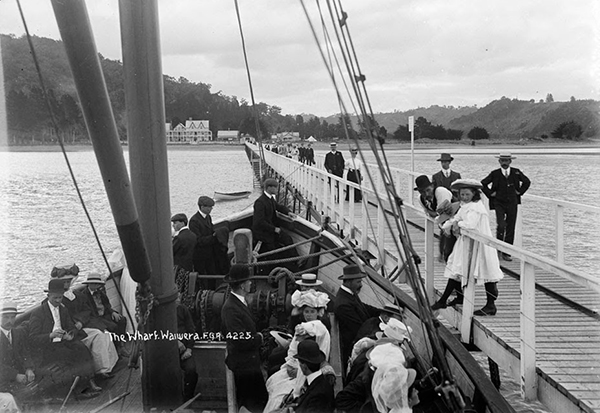
Waiwera Wharf Long-Shot: Although long derelict by then, the prodigious Waiwera Wharf was extant when the modern, recently demolished Waiwera pools were first established, in the late 1950s. The Buy these The actual campaign title would need to be much punchier, possibly “Buy Waiwera!” Such a provocative slogan, however, would first need to be canvassed with, and blessed by, current Waiwera residents brand-new old Waiwera pools!The actual campaign title would need to be much punchier, possibly “Buy Waiwera!” Such a provocative slogan, however, would first need to be canvassed with, and blessed by, current Waiwera residents campaign would also fund the wharf’s buoyant and geomorphically curvaceous revival—a maritime structure of rare beauty bejewelling Waiwera’s demure charms.
photographer Frederick George Radcliffe
Demolition of the derelict Waiwera pools infrastructure was inevitable. However, the fate of the revered hot mineral pools is potentially far more miserable for the memories of the millions of Aucklanders who had ever made it their mecca.
For what now feels an eternity, the future planned for the heart and soul of Waiwera has been as a high-end wellness centre, where there would be scant opportunity for new generations of young people to form early memories with family and friends. But now, suddenly on the open market, all bets are off. Aucklanders, consummately, passionately organised, could outbid any potential foreign owner.
Waiwera has all the necessary ingredients to be transformed into a literally unique, charitable-trust-owned self-funding paradise. The setting is everything—intimate and proximate. When Auckland became determinedly private-light-vehicle-centric in the aftermath of World War II—particularly post the Auckland Harbour Bridge—Waiwera was the comfortable northern limit of a day trip in the family car. Patronage of the Waiwera pools, in the years leading up to the opening of neighbouring Wenderholm Regional Park, doubled year on year. Without Wenderholm’s wide acreage of parking and picnickingalways a struggling speller, one word the writer never again misspelt was picnicking, after been made aware of his error, after the completion and erection of his first largescale signwriting job, at the Waiwera pools: “Free parking and picnicing” space, the intimacy of Waiwera would have become unbearably fetid. An aerial photograph of that era shows every last inch of roadside jammed with cars and buses—a far cry from the genteel days of the wharf most of the way out to Mahurangi Island, and steamboats discharging day trippers.
Waiwera water emerges naturally at the perfect heat to fill a cast-iron bath. Robert Graham’s gracious Victorian hotels, and the makeshift establishment built following their arson, had a bathhouse at the rear. The row of bathrooms therein each sported an oversized enamelled bath, which once its mass had taken the sting out of the 47°c bore water, retained the bathwater at a temperature that left the bather glowing while they dried and dressed for dinner, or bed.
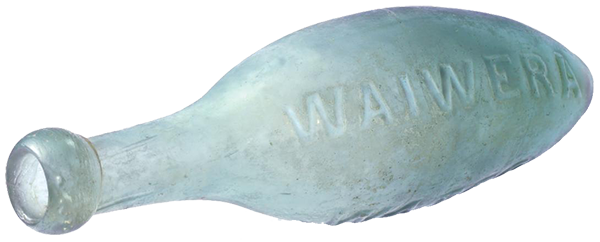
Inspiring Best Bottle in Glass: Not everybody would have seen the potential of Waiwera’s historic fiasco water bottle. In 2006, Waiwera Infinity’s infinitely elegant design by David Melrose won the fifth annual international bottledwaterworld.com best-bottle-in-glass award, in Bergamo, Italy.
image Waiwera Infinity
The water is also entirely imbibable—raw and warm, but vastly more marketable lightly carbonated, lavishly bottled, and chilled.
Then there is the darling setting. A bay sufficiently spacious for a village, sheltered by hills firmly cloaked in indigenous coastal forest. Tangata whenua enjoyed it best for the better part of a millennia, excavating pools in the beach sand and soaking in the richly rejuvenating warmth, with little between them and the cleansing ocean. This pristine pleasure was still available in the early years of the modern Waiwera pools, until excessive bore drawdown dwindled the flow. Subsequently, 1960s–70s patrons were granted passes to freely transition between pools and beach, before Waiwera became a mean-minded money-making machine.
Last paragraph
In the spirit of readers deserving to know—ahead of wading through an article—whether the effort is potentially worth their attention! With everything to play for and nothing to lose, for Aucklanders to take less than their best pools-not-apartments shot, would be unconscionable. Sure, Buy these brand-new old Waiwera pools!The actual campaign title would need to be much punchier, possibly “Buy Waiwera!” Such a provocative slogan, however, would first need to be canvassed with, and blessed by, current Waiwera residents is a Mahurangi moonshot, but pull that off, and the next hero project will look entirely achievable. Three in a row would start to make Waiwera to Waipū look little short of inevitable. Four in a row, and [insert moonshot on-the-scale-of-ending-child-poverty-in-Aotearoa of your wildest dreams here] could be there for the taking.
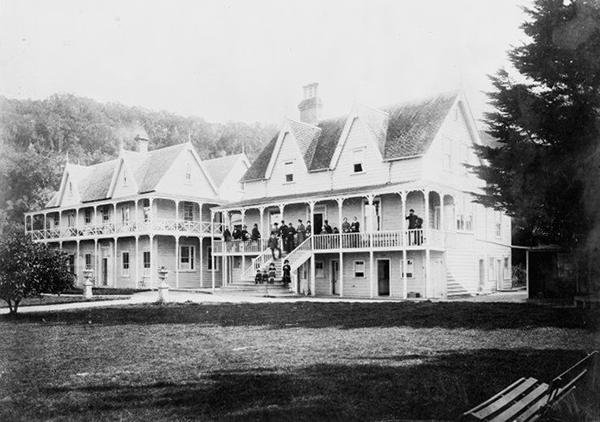
Buoyant Beginning – Buoyant New Beginning: When the building on the left—one of the many built in Thames and Grahamstown during the 1867 gold rush—joined its cousin on Waiwera Beach, few human beings could envisage that the fossil reserves fuelling the Industrial Revolution would, within a century, be providing a post-Biblical dimension to the sermon regarding building upon the sand. Rather than retreat, Waiwera can be lovingly resurrected, piece by piece, to enjoy an entirely, literally buoyant, future.
image Jade River: A History of the Mahurangi
Setting aside the sorry saga of failed Russian ownership, the pools infrastructure dating from the 1950s was always unlikely to survive a full century, even without the now-irreversible disintegration of the 2.9-million-cubic-kilometre Greenland Ice Sheet. With retreat finally now being acknowledged in polite governmental circles, building any non-buoyant structure on the Waiwera pools site would be the height of irrationality, except that that is entirely what is likely to occur, such is the dearth of rigorous risk-assessment around sea-level rise. Serendipitously, there is Waiwera precedent—of sorts—for floating hot-pool hotels: one of the pair of Victorian-era buildings began life on the far side of the Hauraki Gulf. After the 1867 Coromandel Gold Rush, it was barged to the Waiwera beach. The trick this time is to leave the hotel on its barge, and the bathhouse, the tea and coffee house, and restaurant, on theirs.
Certainly, boatyard-built barges and their hotel and bathhouse superstructures could be winched ashore onto the hot-pools property. However, the rational approach would be to simply grass those areas and use them for picnicking and camping, for that part of the century they survive increasing inundations. In the interim, the buoyant bathhouse and hot pools, and other buildings, could bide their time beside a buoyant, beguilingly serpentine, latter-day Waiwera Wharf.
Aside from the proximate needs of Waiwera, the world desperately needs imaginative, attractive, and exciting examples of climate adaptation. Exciting, for many, may be too insensitive a word, given the scale of biodiversity and other loss that unbridled economic growth has inflicted globally. In the word’s sense of, to cause or bring about, meaningful climate action urgently needs to be excited. Besides, the prospect of fighting a war, famously, has long been documented as sufficiently exhilarating for droves of young men to falsify their age, least they miss out on the action. The battle to adapt to sea-level rise will be prolonged—measured in centuries and parts thereof; the crucial metrics by 2100 will be the rate of rise and its rate of acceleration, not the datum at that notional juncture. Even the most extreme, high-risk geoengineering is unlikely to stabilise the world’s great icesheets in time to avert—over an as-yet-unknowable timescale—multi-metre sea-level rise. Given the clean-slate—almost, greenfield—state of the Waiwera site, it would be perverse, and self-defeating, to only marginally build-back-better. Waiwera is a high-visibility opportunity to demonstrate a bold, buoyant response—unrestrainedly embracing the opportunity it has been bequeathed.
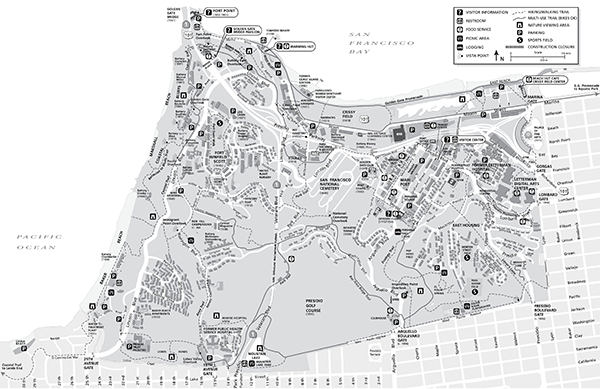
Glorious Military Imprecision: Contrasting gorgeously with the regimented San Franciscan city-street layout, with its former-military-fort Presidio National Park demonstrates, at scale, what nimble minds can create. Rather than sell off the bricks and mortar and preserve only the green open space, the entire organically evolved site was kept intact, with the income of tenants prepared to cohabitate with park users paying for park development and upkeep—an entirely too elegant and practicable a concept to be the product of neoliberalists, who blindly would have privatised the entire 600 hectares.
map United States National Park Service
Was MakaurauStrictly, Tāmaki Makaurau, but Mahurangi Magazine’s longstanding suggestion as the name for the broader, Auckland Council governance region still basking in its early regional-parks heyday, the acquisition of the Waiwera pools by its council would have barely raised an eyebrow. The acquisition of Wenderholm was greeted with great enthusiasm, helped hugely by Judge Arnold Turner’s insistence that it be opened the following summer. But rather than lament the passing of that heroic era, a new, bold, sustainable one can be engineered, by demonstrating that ordinary Aucklanders, rather than writing off Waiwera exclusively to the well-heeled, can buy the site and all be enjoying it, once again. And go on to repeat the success, wherever the government—national, regional or local—or commercial interests, turn a determinedly deaf ear to the people. Current crowd-funding platforms, however, are not capable of repeating the ebullient “Buy this Beach”Not the name given by the men who made it happen—Adam Gard’ner and Duane Major—but by Stuff, which provided crucial mainstream-media publicity campaign that totally captivated New Zealanders one New Year’s holiday, coming up for nine summers ago. Waiwera, as luck would have it, is big enough to justify putting together the compounding crowdfunding-app-with-a-difference a dysfunctional world is crying out for. For the generations who were riveted during the 18-year span of tv2 Telethons, brothers-in-law duo Adam Gard'ner and Duane Major were a wholesome tonic, their seemingly effortless campaign generating a great groundswell of goodwill. A Buy these brand-new The actual campaign title would need to be much punchier, possibly “Buy Waiwera!” Such a provocative slogan, however, would first need to be canvassed with, and blessed by, current Waiwera residents old Waiwera pools!The actual campaign title would need to be much punchier, possibly “Buy Waiwera!” Such a provocative slogan, however, would first need to be canvassed with, and blessed by, current Waiwera residents campaign would need be of sufficient scale to successfully launch a killer, post-Telethon, post-Givealittle platform. The amount raised by the 1981 Telethon, in today’s housing figures—$126 million—would more than comfortably see the public soaking in the first of the hot new pools.
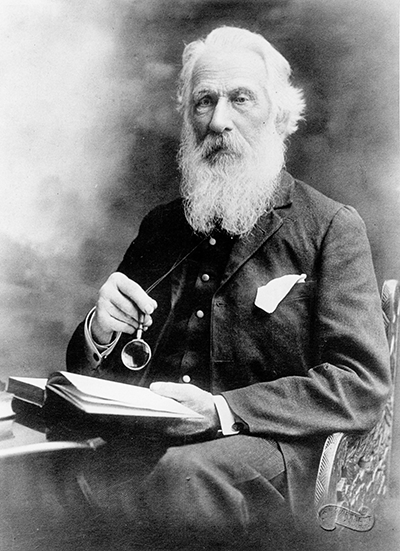
Self-Funding Parks Century Behind His Time: Sir John Logan Campbell beat San Francisco to self-funding parks by 93 years, and the Sydney Harbour Federation Trust by an even century. Aotearoa, meantime, has yet to catch up with itself, although Buy these brand-new old Waiwera The actual campaign title would need to be much punchier, possibly “Buy Waiwera!” Such a provocative slogan, however, would first need to be canvassed with, and blessed by, current Waiwera residents pools!The actual campaign title would need to be much punchier, possibly “Buy Waiwera!” Such a provocative slogan, however, would first need to be canvassed with, and blessed by, current Waiwera residents and Logan-scale courage, could yet kickstart that, and begin to make up for lost time.
photographer W H Bartlett
With the current, abjectly anaemic political appetite for meaningful climate action—much less, climate-action mobilisation—the hero sea-level-rise-savvy project needed for Waiwera’s redemption doesn’t stand a snowball’s chance in Flaming Mountains in Xinjiang, China, which recorded a >80-degree C surface temperature on 16 July 2023 hell of being instigated by council or central government. Was Waiwera to lend its good name to the first demonstration of an empowering new crowd-and-state-funding paradigm, in addition to Waiwera directly benefiting, it would pay the favour forward for hero, public-good projects elsewhere in the motute reo Māori: island, or, in this context, the islands that make up Aotearoa—New Zealand . Regardless of how widely the model was distributed, arguably there is a need to first demonstrate and prove its potency at a subregional level, such as the Mahurangi component of the Kaipara ki Mahurangi electorate, if not a rohete reo Māori: territory or boundary somewhat closer to the Mahurangi hydrological catchment. In any given geographic community of interest, there will always be projects competing for prioritisation. The same platform could be deployed to test where there was sufficient appetite to support at-scale projects such as the herein mooted Buy these brand-new old Waiwera pools!The actual campaign title would need to be much punchier, possibly “Buy Waiwera!” Such a provocative slogan, however, would first need to be canvassed with, and blessed by, current Waiwera residents campaign, and to gauge the relative support for the various candidates.
One icon, in respect to the new Waiwera pools, will be about the last thing to be rebuilt: the waterslide. Waterslides, aside from the obvious thrill-seeker appeal, are probably the most wasteful users of naturally heated mineral water conceivable—cooling towers with benefits. Prior to Waiwera’s waterslide era, the reticulation was meticulously configured to extract every joule of nature’s bounty. The waterslides were added without a commensurate increase in pool filtration capacity. Appallingly, the pool that demanded and received the highest flow of freshly filtered and disinfected water—the children’s paddling pool—was deprived of that supply and fed with the dirtiest water in the system—the body-secretion-rich water skimmed untreated off the surface of the adjacent, newly added indoor pool.
Riotously lucrative, the waterslides were the signal feature of an increasingly heartless era, both at the pools and in New Zealand society generally. During the first two decades of the post-war pools, the admission charge gradually rose to the equivalent of only $6.55 in today’s currency—the epitome of family friendly, and family affordable, before successive governments embarked on the policies that remorselessly led to Aotearoa having one of the highest rates of child poverty in the Western world. When it is time to revisit waterslides—Waiwera, with its rich, natural bounty, arguably has a moral duty to help address New Zealand’s shameful drowning fatality rate. Subsequent catering for the more boisterous might begin with simple, wholesome rope swings into the invigorating waters of the Hauraki, from the end of the new Waiwera Wharf.
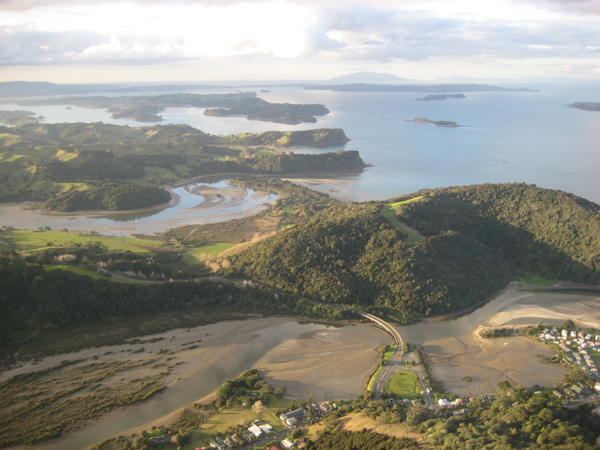
Gateway Drug: Urban Partners well recognised than any potential partner in the development of its Waiwera properties would be impressed with the natural coastal geographic wealth that lay immediately to the north—not least the 1000 hectares of regional reserve, and the Mahurangi Coastal Path provided for in its 10-year management plan.
image ImageShack
In Seacoast in the Seventies – The Future of the New Zealand Shoreline, co-author Ron Locker passionately argued for Mahurangi to become the first of a new breed of coastal national park. As worthy a concept as that was, in the event—as he explains in Jade River: A History of the Mahurangi—the one-major-park-every-other-year momentum of the Auckland Regional Parks network addressed the urgent need to save the Mahurangi coastline from coastal ribbon development. And while national parks have much to commend them, so does a mixed-use approach that doesn’t require every inch to be in public ownership, not least of all, in the vanishingly distant likelihoodwhich would require the reversal of law changes made after the initial, coastal margin of Te Muri, for example, was forcibly acquired of significant property holdings being nationalised in peacetime. Even coastal-retreat should surely be primarily predicated on willing-buyer – willing-seller transactions, whilst acknowledging that sea-level rise will sometimes force forcible acquisition—particularly where foot-dragging has cut off more creative options.
Most would anticipate that any entity established to revive the Waiwera pools would be titled Waiwera. Mahurangi might, however, be preferable, to signal that, as Urban Partners astutely judged, Waiwera is not just Waiwera. Waiwera is the gateway to a magnificent stretch of largely unbuilt coastline, 1000 hectares of which is regional parkland. But to access that superb, contiguousassuming, civilised, infrastructure to cross various waterbodies coastal parkland, has proven to be a Mahurangi moonshot on its own. The first, obvious link was the modest footbridge conceived in the 1980s to head off a terminally private-light-vehicle plan the build a road bridge across Te Muri Estuary. The cause had to be replicated after the 383-hectare, willing-buyer – willing-seller purchase that crowned the two-decade earlier compulsory coastal acquisition. Now, since that successful campaign was enshrined—by the 10-year, 2022 regional parks management plan—the way might have been clear to cross Te Muri Estuary. In the interim, however, it had been increasingly apparent that, in order be part of the meaningful climate-action solutions so scarily slow in coming, the Mahurangi Coastal Path can no longer responsibly be built incrementally. First and foremost, from day one, it must be connected to public transport. This new, low-carbon imperative is also a child-poverty-mitigation prerequisite—as per the Mahurangi Coastal Path Gluckman gauntlet. Ideally, for reasons that largely escape mainstream-media reporting but are abundantly obvious to the energy and urban-transport literate, the aforementioned public transport, to the nearest local node, should be grid-powered—read, in the absence of electrified rail: in-motion-charging trolleybuses.
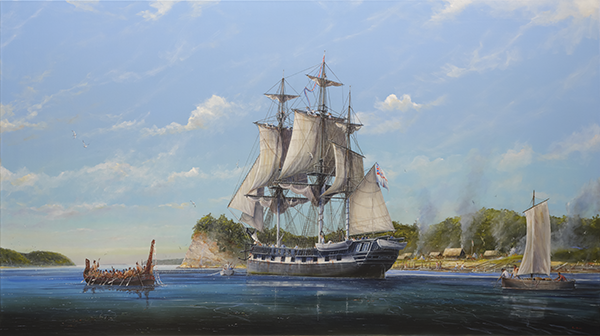
Visiting Aotearoa for all the Right Long-Stay Reasons: First person to pony-up to commission this depiction of the Auckland region’s first Pākehā settlement in Spar Station Cove, Mahurangi Harbour—J Barry Ferguson—saw no reason a replica of the hmss Buffalo could not follow. What could be a cross-cultural triumph would be a matching pair of replicas of the spar ship and te waka taua, so evocatively depicted here.
marine artist Paul Deacon
Secondly, to further ensure that the coastal path doesn’t add to the current private-light-vehicle-centricity of the regional parks, it should also connect to Pūhoi, via a new, terrestrial section of Te Araroa, the national walkway. In all, three footbridges are called for—one of quite some significance—but, in addition to the coastal path and the new Te Araroa link, would create a 17-kilometre Waiwera–Wenderholm–Te Muri–Pūhoi–Pūhoi River–Waiwera loop walk. Without an enabling platform such as that suggested here to buy Waiwerato paraphrase the late, great Jimmy Buffet: “…made enough money to buy Miami…”, councils are no longer capable of delivering legacy projects.
The third Mahurangi moonshot might be another superbly self-funding concept: the Mahurangi Riverpath, from Warkworth to the Wilson Cement Works. Buoyant, and benefiting out-of-the-blue from the covid-19-stimulus dredging, the riverwalk would transform the town from a coffee stop to a day-visit, or overnight, destination. Again, self-funding, thanks to the say 100 berths the “marina”, river face of the snaking, nautical-mile-long pontoon would affordcreate. There is little doubting the urgent need for the Mahurangi River’s tidehead town to re-invent itself, following the opening of the Pūhoi–Warkworth motorway. Without the massive fundraising machinery planned by the proposed Mahurangi Heritage Trust, attracting sufficient money to stabilise the Wilson Cement Works archaeology will possibly prove elusive, with successive governments engaged in a deficit-reduction-competition race to the bottom. It will take, if not the machinery of an entity such as the envisaged Mahurangi Heritage Trust to raise the tens of millions needed to render the site sufficiently safe to attract visitors at scale. Then there is the frequent ferry service needed to ensure equitable access, for extremes of age and mobility. That, and a Mahurangi Heads cross-harbour ferry, would be impeccably instructive opportunities to deploy and demonstrate considered battery power—taking a leaf from the two-to-ten-times-less-embedded-battery, in-motion-charging-trolleybus book.
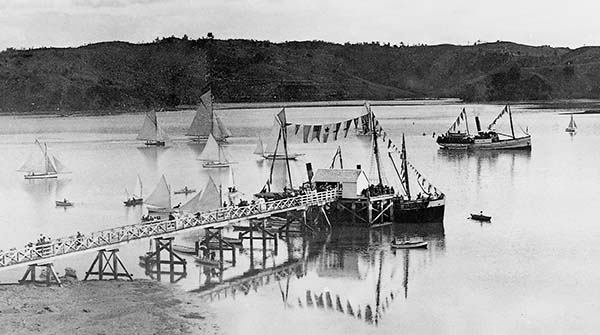
Drifting Down to the Wire: Image and caption once ensured that an earlier Mahurangi moonshot was successfully launched, to help prise the hands of a rogue chairman intent on dishonouring Mahurangi Action’s undertaking to publish Jade River: A History of the Mahurangi, from the helm. Now, could another instance in time that this sublime image works its magic, on the mother-of-all Mahurangi moonshots.
photographer Henry Winkelmann
Waiwera thus accessed, revived in its venerable role as a place where all walks rejuvenated, becomes a gateway to a more hopeful, genteel, world; an informed-futures exemplar, providing a plethora of all the right reasons for long-stay-visiting Aotearoa.
Actual last paragraph
In the spirit of readers deserving to know—ahead of wading through an article—whether the effort is potentially worth their attention! With everything to play for and nothing to lose, for Aucklanders to take less than their best pools-not-apartments shot, would be unconscionable. Sure, Buy these brand-new old Waiwera pools!The actual campaign title would need to be much punchier, possibly “Buy Waiwera!” Such a provocative slogan, however, would first need to be canvassed with, and blessed by, current Waiwera residents is a Mahurangi moonshot, but pull that off, and the next hero project will look entirely achievable. Three in a row would start to make Waiwera to Waipū look little short of inevitable. Four in a row, and [insert moonshot on-the-scale-of-ending-child-poverty-in-Aotearoa of your wildest dreams here] could be there for the taking.
Not to mention regatta week Few, today, are aware that for the decade before World War II brought the Mahurangi Regatta to a halt, Waiwera hosted its after-match function. Held in the still extant, wonderfully named Waiwera Gaiety Hall, Waiwera provided the hospitality and entertainment that Scotts Landing couldn’t readily, after losing its unmaintained wharf. The Mahurangi Regatta, meantime, having reached peak private-light-vehicle access, is in the process of being reinvented, as a regatta week, culminating in an Aotea ki Mahurangi waka ama ocean race, possibly on Waitangi Day. The ocean race planned by Mahurangi-based Ngāti Maraeariki could reinvent Auckland Anniversary weekend as the finale of a Tātaki Auckland Unlimitedpreviously ATEED—Auckland Tourism, Events and Economic Development-scale, “Waitangi week”. This is because of the part of the huge, international following enjoyed by the event’s inspiration—Hawaii’s Moloka'i Hoe—would beat a path to Mahurangi. Designed from the ground up to revolve around public transport and low-key, family-affordable camping, for many young Aucklanders, it would be their end-of-the-golden-weather opportunity to learn traditional camping, canoeing, sailing, and boat-building, skills.
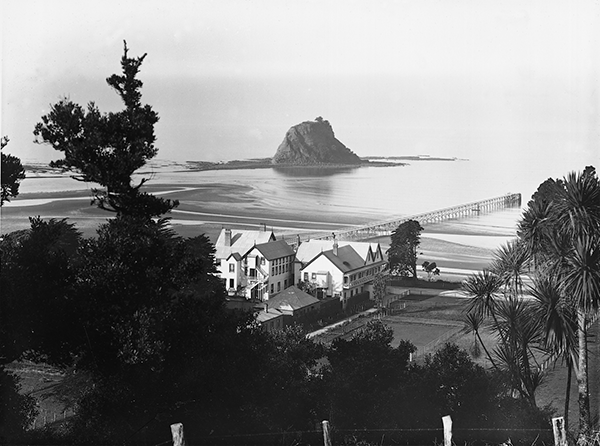
Waiwera–Mahurangi: Long before the coastline from Waiwera north became known as Mahurangi, the name strictly applied just to the sea-stack redoubt of Mahurangi, off the beach at Waiwera, and the great pā of Kākaha, on the prominent Maungatauhoro headland immediately north the Waiwera River mouth, overlooking Wenderholm.
photographer Henry Winkelmann
Buy Waiwera plan b An end-to-end Mahurangi Coastal Path would make for a stunningly salubrious Plan B. For strategic reasons, however, it would be far preferable for it to be Buy Waiwera – phase 2. But, setting aside those myriad reasons for a moment, a little about Buy Waiwera plan b – Mahurangi Coastal Path, end-to-end:
An end-to-end Mahurangi Coastal Path would, in fact, be end-to-ends, given that the Waiwera end would connect to Pūhoi, inland, and to Martins Bayor Algies Bay, should public transport, independently, not yet extend to there, to the north. Connecting to Pūhoi also means connecting to Te Araroa, the national walkway. And not merely connecting to it, but providing it with a world-class, stupendously scenic first, great, link from coastal suburbia to rural pastureland and indigenous forest, via the splendid isolation of Te Muri. Such a link would introduce more young New Zealanders to the magnificence of backcountry Te Araroa than any other measure conceivable, and help build pride in what desperately needs to be embraced as New Zealanders’ big, indigenous, low-carbon oe, and invested in. Te Araroa, appropriately funded, must represent New Zealand’s single greatest social and economic opportunity imaginable.
These connections also provide the opportunity for grand, day- and overnight- loop walks. These and a rich range of other recreational and cultural opportunities are detailed in the joint submission to the Auckland Regional Parks management plan made by Mahurangi Action and the Mahurangi Coastal Path Trust, and by that made by Ngāti Maraeariki.
The overall cost-benefit…
Disclosure The author of this article is the secretary of both Mahurangi Action Incorporated and the Mahurangi Coastal Path Trust, and has voted Māori, more than once. The article published here, however, is that of the editorially independent, independently funded Mahurangi Magazine.
 1 2 3 fix mmp
About, about…
Annual report
chart competition
Climate-action mobilisation
hmss Buffalo
Jade River: A History of the Mahurangi
Mahurangi Action Inc.
Mahurangi Action Plan
Mahurangi Coastal Path
Mahurangi Gallery
Mahurangi Magazine
Mahurangi Regatta
Open-ground indigenous plants establishment trials
Regional parkland
Watermills, millraces, dams and weirs
1 2 3 fix mmp
About, about…
Annual report
chart competition
Climate-action mobilisation
hmss Buffalo
Jade River: A History of the Mahurangi
Mahurangi Action Inc.
Mahurangi Action Plan
Mahurangi Coastal Path
Mahurangi Gallery
Mahurangi Magazine
Mahurangi Regatta
Open-ground indigenous plants establishment trials
Regional parkland
Watermills, millraces, dams and weirs








